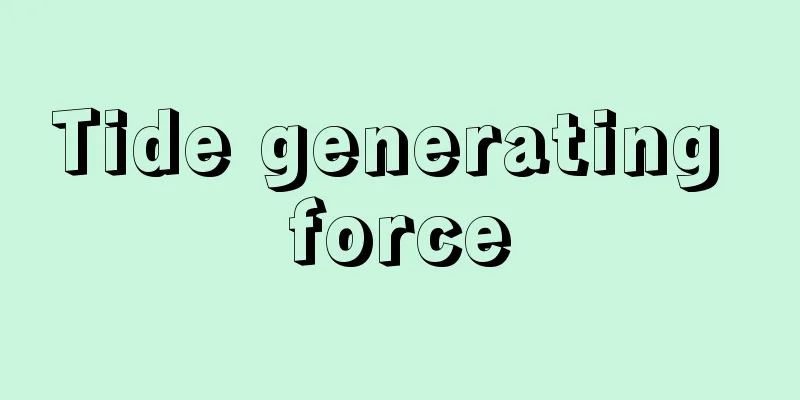Tide generating force

|
The direction and magnitude of the gravitational forces of the Moon and the Sun differ slightly at different points on Earth, causing the movement of ocean water and deformation of the Earth, resulting in tides. The force generated by the gravitational effects of other celestial bodies is called the tidal force. The Earth and Moon move in a circular motion around their common center of gravity, going once every sidereal month (about 27.3 days), with overall gravitational and centrifugal forces in balance. Centrifugal force is the same at any point on Earth, but the gravitational force of the Moon is inversely proportional to the square of the distance between that point and the Moon, so it is larger at points closer to the Moon and smaller at points farther away. For this reason, directly under the Moon the Earth bulges toward the Moon, and at the opposite point, the centrifugal force is greater than the gravitational force, so it acts to bulge in the opposite direction from the Moon. The middle part becomes concave. In other words, the tidal force acts to deform the Earth into the shape of a rugby ball. Tidal forces are also generated on Earth by the Sun for the same reasons as the Moon. The magnitude of the tidal force is proportional to the mass of the celestial body and inversely proportional to the cube of the distance from the Earth. The Sun has a much larger mass than the Moon, but because it is farther away, its tidal force is just under half that of the Moon (46% on average). Other celestial bodies are extremely small because they are very far from the Earth or have small masses. The magnitudes of the tidal forces of the Moon and the Sun at their greatest are equivalent to tidal ranges of 53.4 centimeters and 24.6 centimeters, respectively. The deformation of the solid Earth is accordingly balanced by the tidal force. However, in the ocean, due to the distribution of land and sea and the inertia of seawater, the magnitude and phase of the tidal force and the tides are greatly different. High tide does not necessarily occur when the Moon reaches its zenith, and there are places where there are almost no tides and places where the tidal range reaches more than 10 meters. [Masami Okada] [References] | | | | | | |©Shogakukan "> Distribution of tidal forces Source: Shogakukan Encyclopedia Nipponica About Encyclopedia Nipponica Information | Legend |
|
月や太陽の引力の方向と大きさが地球上の各地点で少しずつ異なるため、海水の移動や地球の変形が生じ、潮汐(ちょうせき)がおこる。このように他の天体引力の効果によって生じる力を起潮力という。 地球と月は、共通重心の周りを1恒星月(約27.3日)で1周する円運動をしており、全体として引力と遠心力がつり合っている。遠心力は地球上のどの地点でも同じであるが、月の引力は、その地点と月までの距離の2乗に反比例するので、月に近い地点では大きく、遠い地点では小さい。このため、月の真下では月のほうへ膨らみ、反対の地点では、引力より遠心力が大きいので、月と反対の方向へ膨らむように作用する。中間部ではくぼむようになる。つまり起潮力は、地球をラグビーボール形に変形するように作用している。太陽の場合も、月と同じ理由で地球上に起潮力が生じる。 起潮力の大きさは、天体の質量に比例し、地球からの距離の3乗に反比例する。太陽は月よりはるかに大きい質量であるが、距離が遠いので、起潮力は月の半分弱(平均で46%)である。その他の天体は、地球からきわめて遠いか、質量が小さいので、起潮力がきわめて小さい。月と太陽の起潮力の大きさは、もっとも大きい地点で、それぞれ53.4センチメートルと24.6センチメートルの潮差に相当する。固体地球の変形は、相応に起潮力につり合っている。しかし、海洋では、海陸分布や海水の慣性などのために、起潮力と潮汐の大きさ・位相は大きくずれており、月が南中した時刻に満潮になるとは限らないし、干満がほとんどない所や、潮差が10メートル以上に達する場所がある。 [岡田正実] [参照項目] | | | | | | |©Shogakukan"> 起潮力の分布 出典 小学館 日本大百科全書(ニッポニカ)日本大百科全書(ニッポニカ)について 情報 | 凡例 |
Recommend
Bukhtarma
…The river is rich in fish, including sturgeon, d...
Mount Mitsumatarenge - Mount Mitsumatarenge
A mountain in the center of the Northern Alps on ...
Kashikodokoro - Kashikodokoro
It is also read as "Kensho." It is the ...
Oga's Pressed Cover - Oga's Pressed Cover
...The main industry is agriculture, mainly field...
angiomatous nevus
…However, the pale pink spots often seen on the u...
Seongjong -
1457-1495 * The 9th king of the Joseon Dynasty. R...
Shimanto River
A river that flows through the western part of Ko...
Ministry of Foreign Affairs - Takumusho
This was the central government agency that manag...
Gua - Gua
...Population: 72,000 (1982). The local name is G...
Takanobu Ryuzoji
Year of death: March 24, 1584 (May 4, 1584) Year o...
Kasuga [city] - Kasuga
A city in the western part of Fukuoka Prefecture, ...
Rotating cannon - Kaikaihou
A large catapult made by Persian engineers during ...
Hessel, JFC (English spelling) HesselJFC
…The mineralogist F. Mohs soon pointed out that t...
Hepatitis A - Hepatitis A
…Hepatitis can be transmitted through epidemics, ...
Tiruvaḷḷuvar (English spelling)
Author of Kural, a classic of southern Indian Tami...









